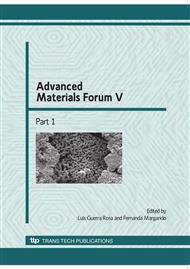p.149
p.155
p.161
p.171
p.177
p.184
p.192
p.198
p.206
Nanocrystallite Characterization of the MMC 316L-0.3%wtY2O3-3%wtTaC by Rietveld Refinement Method
Abstract:
The nanocrystallites in a metal matrix composite (MMC) have wide importance in the sintering area. The nanocrystallites have been related with properties such as hardness and density of 316L steel matrixes. The Y2O3 and TaC dispersion in steel crystalline structures affects these properties and the sintering process. This study analyze: the 316L steel, Y2O3 and TaC crystallite size; TaC and Y2O3 dispersion in milled powder composite; MMC nanocrystallite size and micro-strain during milling process of 316L-(CFC) steel and the effects of dispersion in sintered MMC. The alloy was submitted to high energy milling. MMC was characterized by scanning electronic microscopy (SEM) and X-ray diffraction (XRD). The diffraction was analyzed by Rietveld’s refinement method, DBWS 9807 program, and crystallite size and micro-strain were performed using Scherrer’s equation and Williamson-Hall’s method.
Info:
Periodical:
Pages:
177-183
Citation:
Online since:
January 2010
Price:
Сopyright:
© 2010 Trans Tech Publications Ltd. All Rights Reserved
Share:
Citation:


